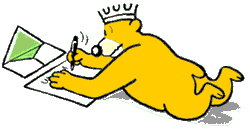11.16 German letter layout
1. Position of the address
Your own address should be the first element of the letter, and you can include your telephone number, fax number and/or E-mail address at the end of this, if you are willing to be contacted in this way. Leave a gap and then type in the address of the person or company to whom you are writing.
Note that whilst telephone numbers are said in pairs, they are written in a business letter as only two numbers, the regional dialling code followed by the actual number. If you are writing from overseas, remember to add the international dialling code.
Both addresses should be positioned flush left on your page and should not contain commas at the end of each line.
If you know the name of the person to whom you are addressing the letter, then this should be included in their address. In such cases the first line of the address should either be "Herrn" or "Frau", depending on the gender of the addressee.
 Grammar 23: Addresses with titles Grammar 23: Addresses with titles |
 |
Herrn
Jan Walle
Lehrter Pfad 34
10825 Berlin |
|
 |
Frau
Irmgard Krznaric
Halker Zeile 4c
9490 Vaduz |
 |
Herrn Doktor
Armin Prill
Bleicherweg 7
8002 Zürich |
|
 |
Frau Professor
Andrea Widy
Kärtnerring 6/3a
1010 Wien |
|
Notes
1. Why is it "Herrn" and not "Herr"? Because you are writing to the man in question, and he is thus in the accusative case. As we have seen in this chapter, "Herr" is a weak masculine noun and thus adds an extra "-n" in all cases other than the nominative singular.
2. If the person to whom you are writing has a title such as "doctor" or "professor", this title is preceded on the first line of the address by either "Herrn" or "Frau" depending on the gender of the addressee.
3. In many cases, the masculine form of the title is used regardless of the gender of the person possessing this title - e.g. "Frau Doktor", "Frau Professor". With some other titles however, the feminine form is used for a female addressee - e.g. "Frau Studienrätin" (= secondary school teacher).
2. The date and its position
The date should be written on the right-hand side of the page. Unlike English which has several variations (May 2, May 2nd, 2nd May etc.), dates in German are always written the same way - der 2. Mai.
At the head of letters, the accusative form is used, preceded by the name of the place from where you are writing - e.g. Portsmouth, den 25. April 2008.
Dates written all in numbers are also found in German, particularly in business letters - e.g. Portsmouth, den 25.04.2008.
3. Dear Sir or Madam
The "Dear Sir or Madam..." line is written flush left on the page.
If you are writing to a firm or an institution and do not know the name of the person to whom you are writing, use "Sehr geehrte Damen und Herren," which literally translates as "Very esteemed ladies and gentlemen" but equates to the English "Dear Sir or Madam". (You should only use "Sehr geehrte Herren," or "Sehr geehrte Damen," if you are sure that the people to whom you are writing are all male or all female.)
The table below shows how you should start a letter when writing to someone whose name you know:
 Grammar 24: Addressing the addressee Grammar 24: Addressing the addressee |
 |
Sehr geehrter Herr Wagner,
("Dear Mr. Wagner,") |
 |
Sehr geehrte Frau Wagner,
("Dear Mrs. Wagner,") |
 |
Sehr geehrte Frau Wagner, sehr geehrter Herr Wagner,
("Dear Mr. and Mrs. Wagner") |
| |
| With titles |
 |
Sehr geehrter Herr Doktor Prill,
("Dear Doctor Prill,") |
 |
Sehr geehrte Frau Professor Widy,
("Dear Professor Widy,") |
|
Notes
1. In this case the person to whom you are writing is in the nominative case. You can tell this by the adjective endings and the fact that "Herr" does not have an "-n" on the end.
2. Note again that "Herr" and "Frau" are retained when writing to someone who has a title.
3. If you are writing to somebody with a title, you should not write their Christian name. Thus the opening formula to write to Professor Andrea Widy is "Sehr geehrte Frau Professor Widy".
4. Body of the letter
The first line of the body of a German letter is not indented, but is positioned flush left on the page.
Note too that - unlike in English - the first word of the body of a letter does not start with a capital letter (unless it is a noun). Why? This is because this first word is only the start of a new clause, not a new sentence. Viewed from a grammatical perspective, it continues the sentence started on the previous line by "Sehr geehrte Damen und Herren,".
5. Ending a letter
Whereas in English we must choose between "Yours faithfully" and "Yours sincerely" when concluding a business letter, the standard ending for a German letter is "Mit freundlichen Grüßen," (= with friendly wishes).
As in English letters you then sign the letter and print your name beneath it.
This is just a brief overview of how to write a German letter. I have constructed a web-site on how to construct a German letter which can be accessed by clicking here.

 Chapter 11.17: Hotel vocabulary (1) Chapter 11.17: Hotel vocabulary (1)
 Nach oben Nach oben
 Print This Page Print This Page
|